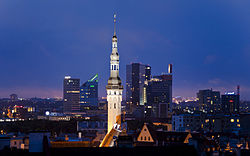
Primate city
Disproportionately largest city in its country or region / From Wikipedia, the free encyclopedia
Dear Wikiwand AI, let's keep it short by simply answering these key questions:
Can you list the top facts and stats about Primate city?
Summarize this article for a 10 years old
A primate city[1] is a city that is the largest in its country, province, state, or region, and disproportionately larger than any others in the urban hierarchy.[2] A primate city distribution is a rank-size distribution that has one very large city with many much smaller cities and towns, and no intermediate-sized urban centers: a king effect, visible as an outlier on an otherwise linear graph, when the rest of the data fit a power law or stretched exponential function.[3]

The law of the primate city was first proposed by the geographer Mark Jefferson in 1939.[4] He defines a primate city as being "at least twice as large as the next largest city and more than twice as significant."[5] Aside from size and population, a primate city will usually have precedence in all other aspects of its country's society such as economics, politics, culture, and education. Primate cities also serve as targets for the majority of a country or region's internal migration.
In geography, the phenomenon of excessive concentration of population and development of the main city of a country or a region (often to the detriment of other areas) is called urban primacy or urban macrocephaly.[6]